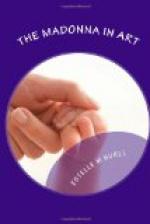[Footnote 4: See the Madonna of the Cherries in the Belvedere at Vienna, and the Madonna and Saints in the Dresden Gallery.]
[Illustration: TITIAN.—MADONNA AND SAINTS. (DETAIL.)]
Another similar composition reveals a still sweeter intimacy between mother and son. The babe stretches out his hand coaxingly towards his mother’s breast, but she draws her veil about her, gently denying his appeal. A more beautiful mother, or a more bewitching babe, it were hard to find. Three fine half-length figures of saints complete this composition, each of great interest and individuality, but not necessary to the unity of action—the Madonna alone making a complete picture. There are two copies of this work, one in the Belvedere at Vienna, and one in the Louvre at Paris.
The motif of this picture is not unique in art, as will have been remarked in passing. The first duty of maternity, and one of its purest joys, is to sustain the newborn life at the mother’s breast. A coarse interpretation of the subject desecrates a holy shrine, while a delicate rendering, such as Raphael’s or Titian’s, invests it with a new beauty. Other pictures of this class should be mentioned in the same connection. There is one in the Hermitage Gallery at St. Petersburg, attributed by late critics to the little-known painter, Bernardino de’ Conti. The Madonna’s face, her hair drawn smoothly over her temples, has a beautiful matronliness. Still another is the Madonna of the Green Cushion, by Solario, in the Louvre. Here the babe lies on a cushion before his mother, who bends over him ecstatically, her fair young face aglow with maternal love as she sees his contentment.
We have noticed that in one of Corregio’s pictures the babe lies asleep on his mother’s lap. It is interesting to trace this pretty motif through other works of art. No phase of motherhood is more touching than the watchful care which guards the child while he sleeps; nor is infancy ever more appealing than in peaceful and innocent slumber. Mrs. Browning understood this well, when she wrote her beautiful poem interpreting the thoughts of “the Virgin Mary to the Child Jesus.” Hopes and fears, joy and pity, are alternately stirred in the heart of the watcher, as she bends over the tiny face, scanning every change that flits across it. Each verse suggests a subject for a picture.
We should naturally expect that Raphael would not overlook so beautiful a theme as the mother watching her sleeping child. Nor are we disappointed. The Madonna of the Diadem, in the Louvre, belongs to this class of pictures. Like the pastoral Madonnas of the Florentine period, it includes the figure of the little St. John, to whom, in this instance, the proud mother is showing her babe, daintily lifting the veil which covers his face.




